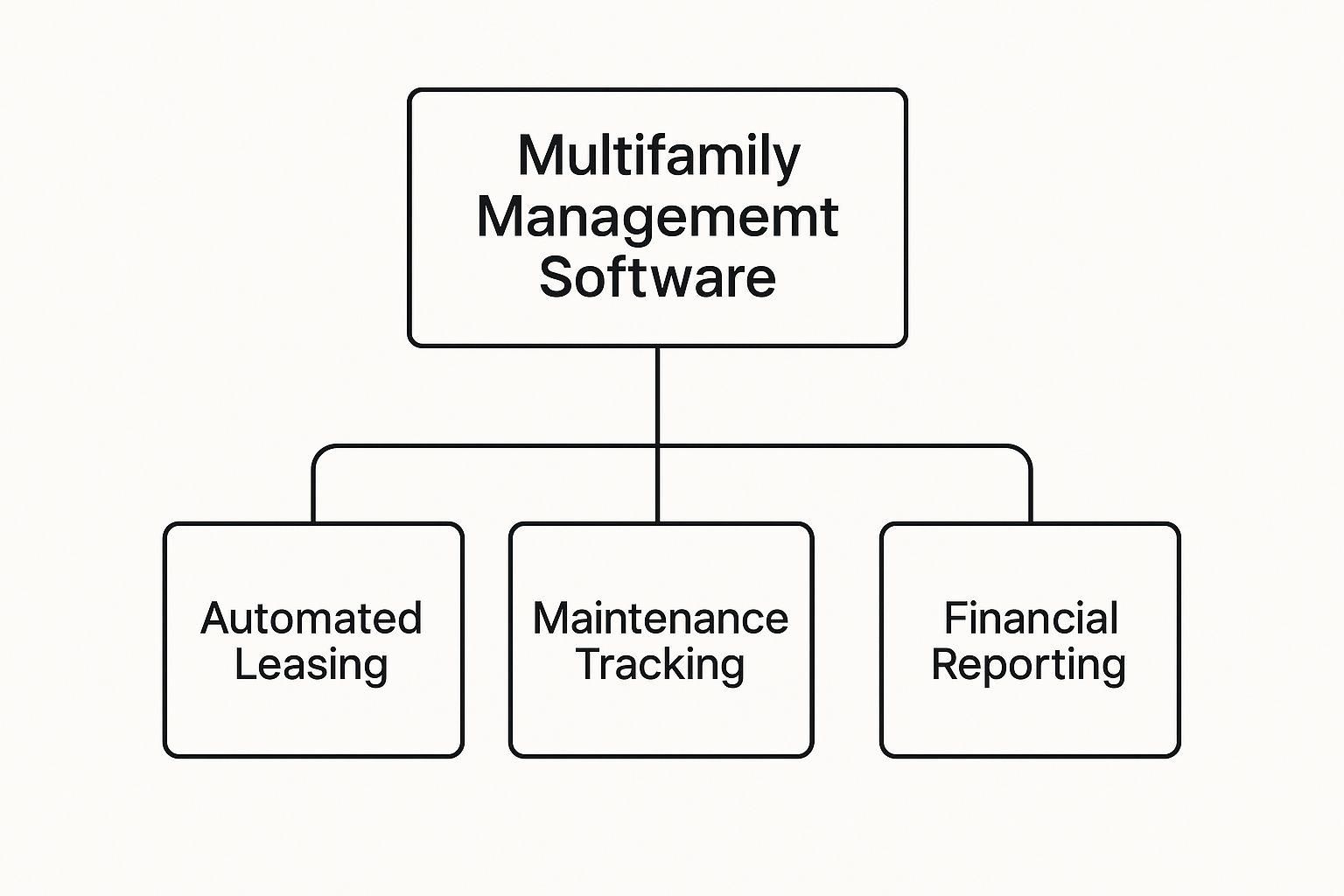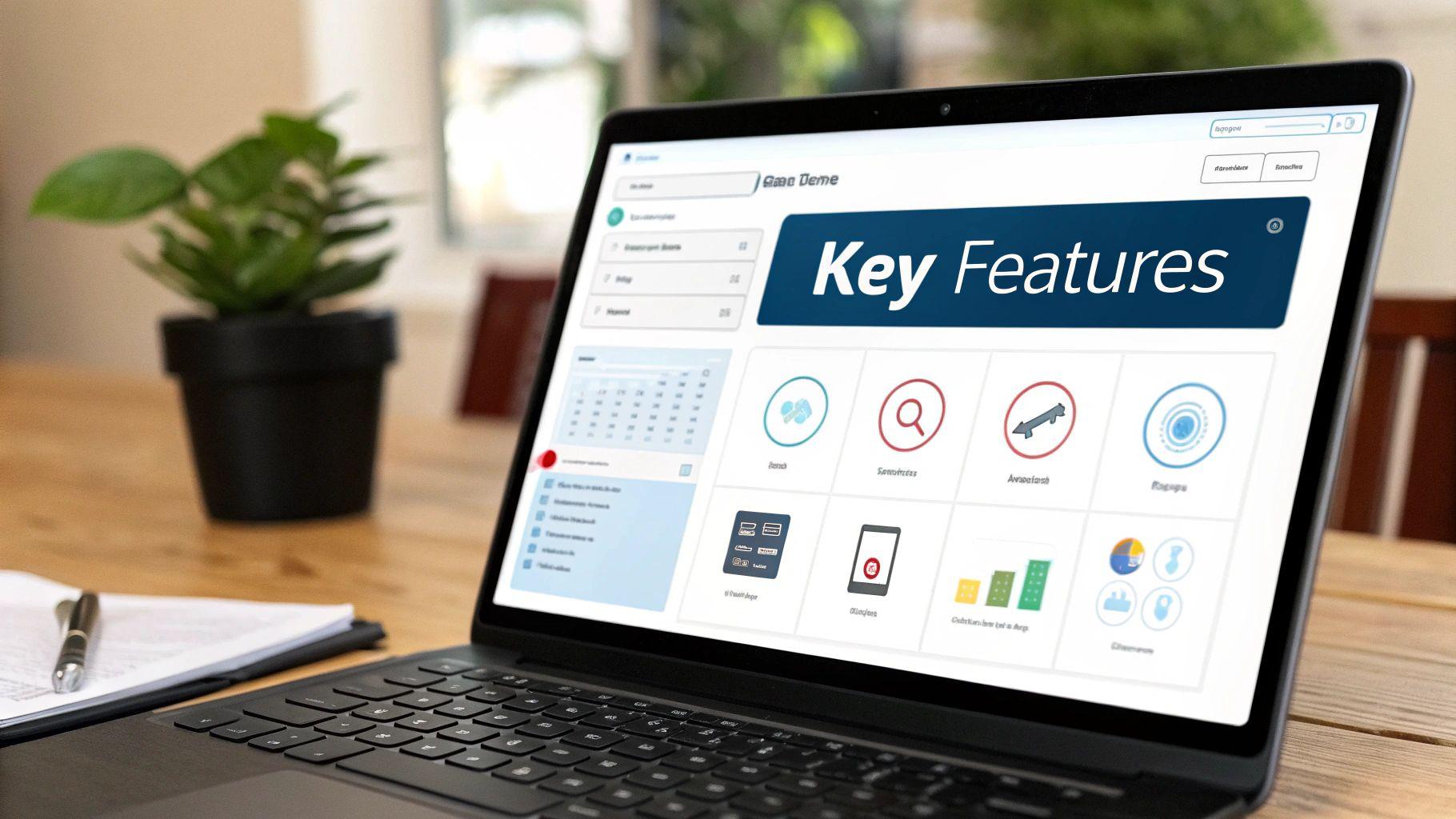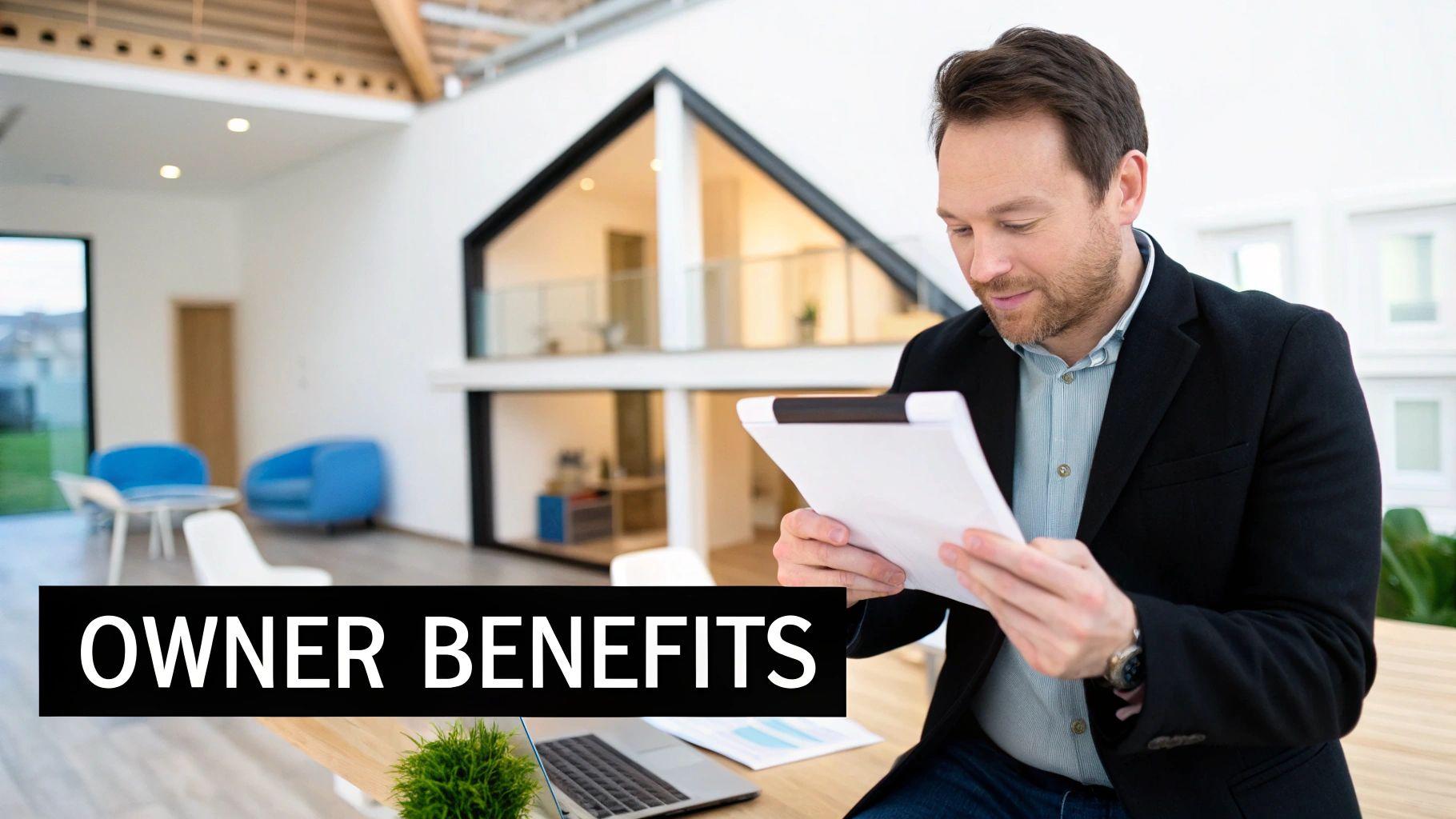A Guide to Multifamily Property Management Software
A Guide to Multifamily Property Management Software
Discover how multifamily property management software can streamline your operations. Learn about key features, benefits, and how to choose the right solution.
Domingo Valadez
Aug 18, 2025
Blog
If you're managing a multifamily property, you know the daily grind. It's a constant juggling act of collecting rent, tracking maintenance requests, communicating with tenants, and trying to keep an eye on the financials. For years, this meant wrestling with a chaotic mess of spreadsheets, sticky notes, and overflowing email inboxes.
Multifamily property management software is the modern solution to that chaos. Think of it as the central nervous system for your building—a single platform designed to automate and organize all the moving parts of running a residential property. It takes all those disjointed tasks and brings them together into one efficient, digital hub.
Understanding Multifamily Property Management Software
Trying to run a property without dedicated software is like trying to conduct an orchestra where every musician is playing from a different song sheet. It’s a recipe for disaster. A good software platform acts as the conductor, making sure every part of your operation—from leasing and maintenance to accounting and resident communication—works in perfect harmony.
The real power here is consolidation. Instead of logging into one system to process a rent check, another to assign a maintenance ticket, and a third to send out a community announcement, you do it all from one place. This isn't just a convenience; it fundamentally changes how you manage your time and your property.
The Three Pillars of Management
At the end of the day, effective property management boils down to successfully handling three core areas: leasing, maintenance, and financials. A centralized software system doesn't just help with these tasks individually; it connects them.

As the image shows, these are no longer separate silos. A lease renewal can automatically trigger a maintenance inspection, and rent payments flow directly into your financial reports. This integration is what gives you a true, real-time picture of your property's health, allowing you to make smarter, faster decisions.
To truly grasp the impact, let's look at how these platforms transform daily operations.
Core Functions of Multifamily Property Management Software
This shift from manual effort to automated control is the key takeaway.
At its heart, multifamily property management software is about replacing manual chaos with automated control. It provides a single source of truth for owners, managers, and tenants, which is essential for scaling a portfolio successfully.
By letting the software handle the routine, repetitive work, property managers can finally shift their focus to what really matters: improving the resident experience and developing long-term strategies for the property. This unified approach delivers some powerful benefits:
- Enhanced Efficiency: Just think of the hours saved by automating rent reminders, lease renewal notifications, and work order assignments. It adds up fast.
- Improved Communication: When all messages live in one central hub, residents feel heard, and nothing falls through the cracks.
- Data-Driven Decisions: With instant access to real-time financial and operational data, owners can spot trends, identify potential issues, and optimize performance before it’s too late.
Essential Features Every Platform Needs

Not all software platforms are built the same. When you start comparing options, it’s easy to get lost in a sea of features, but a few core functions are absolutely non-negotiable for running a modern property. Think of this as your buyer's guide—a checklist of the tools that separate a truly powerful system from a glorified digital filing cabinet.
The right multifamily property management software should be your operational command center, handling the daily grind so you can focus on the big picture. Without these key features, you're really just buying a more expensive spreadsheet.
Unified Financial Management
First and foremost, you need a robust financial engine. This is about so much more than just collecting rent. It’s about creating a smooth, connected flow of financial data—from the moment a tenant pays to the second you pull a report—and cutting out the manual entry that breeds human error.
A top-tier platform has to include:
- Automated Rent Collection: Let’s be honest, chasing down rent is a huge time-sink. Your software should give residents multiple ways to pay online (ACH, credit card) and automatically send reminders for upcoming and late payments. This one feature alone can work wonders for your cash flow.
- Comprehensive Accounting: You need the ability to track every dollar in and out, generate instant rent rolls, and pull detailed financial statements like P&Ls whenever you need them. This gives you a real-time pulse on your portfolio's financial health.
- Vendor and Invoice Management: A good system lets you pay bills, track maintenance invoices, and manage vendor details all in one place, keeping things clean and organized.
Centralized Resident and Leasing Hub
A great resident experience is the bedrock of high retention. Modern software can shift the manager-tenant relationship from being purely reactive (only talking when there’s a problem) to one that’s proactive and convenient. The same goes for leasing—it should be a seamless digital journey from the first click to the final signature.
Look for a system that puts all resident-facing activities under one roof:
- Resident Portal: This is their digital home base. It's a secure spot where tenants can pay rent, log maintenance requests, check their lease documents, and get community updates.
- Communication Tools: You need an easy way to send mass emails, texts, or in-app messages to everyone or just a specific building. It’s invaluable for everything from emergency alerts to reminders about a community BBQ.
- Digital Leasing Workflow: The software should handle the entire leasing lifecycle, from online applications and tenant screening to digital lease signing. This helps you turn units over faster.
The goal here is a low-effort experience for everyone. When residents can solve problems and find information on their own, satisfaction skyrockets. In fact, research shows that tenants who are happy with their property management are 30% more likely to renew their lease.
Integrated Maintenance Management
For many residents, maintenance is the most direct and memorable interaction they'll have with management. A clunky, disorganized process leads to frustrated tenants and bad online reviews. The right platform turns maintenance into a streamlined, transparent operation.
This means having a work order system where residents can submit requests with photos, tickets are automatically assigned to the right person, and everyone can see real-time status updates. That transparency alone builds a ton of trust and goodwill.
The demand for these all-in-one systems is causing the market to explode. The global property management software market is projected to jump from USD 5.32 billion in 2025 to USD 16.83 billion by 2035. This growth is all about the need for platforms that can make complex operations feel simple. You can discover more about this market expansion and its key drivers.
Key Benefits of Adopting a Modern Solution

Ditching the old-school spreadsheets and paper trails isn't just an upgrade; it’s a complete overhaul of how you run your properties. Bringing in a modern multifamily property management software delivers real, measurable results. It automates the tedious stuff, freeing up your team to focus on what actually matters—growing the business and keeping residents happy.
The first thing you’ll notice is how much time you get back. Think about it. How many hours a month are lost chasing late rent, manually entering data, or playing phone tag to schedule a simple repair? Good software handles these repetitive chores, letting your team shift from just managing tasks to managing your strategy.
Achieve Major Time and Cost Savings
Automation is your best friend when it comes to efficiency. When you take routine tasks off your team's to-do list, you're not just saving a few minutes here and there. Those minutes add up to serious hours. That’s time you can put back into building relationships with tenants, marketing empty units, or scouting out your next investment.
This newfound efficiency also translates directly to cost savings. Fewer manual errors mean less money wasted on fixing mistakes. Think streamlined vendor payments, smarter maintenance scheduling, and quicker unit turnovers—it all adds up to a healthier bottom line. For property owners, a well-oiled machine is a profitable one. To really get into the weeds on this, check out our comprehensive guide to multifamily investing to see how operational excellence drives financial success.
Elevate the Tenant Experience
In today’s rental market, your biggest advantage isn't just the property—it's the experience you provide. Modern software gives tenants the kind of smooth, on-demand service they've come to expect in every other part of their lives. A simple resident portal where they can pay rent, log a maintenance request, or get community updates empowers them and cuts down on frustrating back-and-forth.
Quick, clear communication builds trust. When a resident can snap a photo of a leaky faucet, submit a work order from their phone, and see its status in real time, they feel heard. The data backs this up: residents who are genuinely happy with their property management are 30% more likely to renew their lease.
The core benefit is shifting from a reactive management style to a proactive one. Instead of putting out fires, you're building a community and an experience that keeps your best tenants happy and your units full.
Unlock Data-Driven Decision Making
Spreadsheets are a rearview mirror; they only show you where you've been. A good software platform, on the other hand, gives you a live, 360-degree view of your entire portfolio. Every rent payment, maintenance ticket, and lease application flows into one central hub, creating a single source of truth.
This centralized data is gold when it comes to making smart decisions. You can stop guessing and start knowing. In just a few clicks, you can generate reports to:
- Spot Trends: Is one building having the same plumbing issue over and over? Are rent payments consistently late in another? Now you'll know.
- Track KPIs: Keep a real-time pulse on crucial metrics like occupancy rates, average days on market, and operational costs.
- Forecast Performance: Use your own historical data to build more accurate budgets and make smarter plans for the future.
Ultimately, this kind of software turns raw data into actionable intelligence. It gives you the clarity to fine-tune your operations, solve problems before they escalate, and maximize the profitability of your investments.
The Next Wave of Innovation in Proptech

The world of property technology doesn’t stand still. Just a few years ago, online rent collection and digital maintenance requests were the big thing. Now, they're just table stakes. The best multifamily property management software is already miles ahead, exploring new ways to manage properties and redefine the resident experience.
When you're choosing a software partner, you're not just solving today's headaches. You're investing in a team that's building the tools you'll need three, five, even ten years from now. The real innovation happening today is all about making buildings smarter, operations more efficient, and life better for the people who call your properties home.
Predictive Maintenance with AI
Picture this: you get an alert that an HVAC unit is likely to fail before it actually dies on the hottest day of the year. That’s the promise of predictive maintenance, and it’s powered by Artificial Intelligence (AI). Top-tier platforms are now using AI to sift through years of maintenance logs, equipment data, and even weather forecasts to spot trouble before it starts.
This flips the script entirely. Instead of scrambling to handle a wave of emergency calls, your team can schedule repairs proactively when it’s convenient for everyone. It’s a win-win—residents avoid frustrating breakdowns, you extend the lifespan of your big-ticket equipment, and you can budget for capital expenses with much greater accuracy.
We're seeing a fundamental shift from the old reactive "break-fix" model to a much smarter, proactive "predict-and-prevent" strategy. This doesn't just make operations smoother; it dramatically improves the resident experience by cutting down on those unwelcome surprises.
The Rise of Smart Buildings and IoT
The Internet of Things (IoT) is another game-changer that’s no longer just a buzzword. It's about connecting everyday devices—from door locks and thermostats to water heaters and leak sensors—to a central hub. Your property management software becomes the command center for this entire smart ecosystem.
What does this look like in the real world?
- Smart Access: Residents can unlock their doors with a smartphone, and you can grant a plumber temporary access to a unit without ever leaving your office.
- Energy Management: Smart thermostats can automatically adjust based on whether a unit is occupied, leading to some serious savings on utility bills across an entire building.
- Leak Detection: Tiny IoT sensors can detect a water leak the second it starts, firing off an instant alert that helps you prevent a minor drip from turning into a major disaster.
This level of connectivity makes buildings more convenient and secure for residents while making them incredibly efficient for you to run. It's no surprise the multifamily software market, currently valued around USD 2.59 billion, is booming as more managers see the competitive advantage. You can dig deeper into the expansion of property management technology to see just how fast things are moving. By getting on board with these innovations now, you’re setting your properties up for long-term success.
How to Choose the Right Software for Your Portfolio
Picking the right multifamily property management software isn't just a purchase; it’s more like hiring a new operations manager for your entire portfolio. The platform you choose will weave itself into your daily workflow, shape how happy your tenants are, and ultimately, affect your bottom line. Rushing this decision is a mistake. A careful, step-by-step evaluation is the only way to find a system that truly fits what you do.
Before you even think about scheduling a demo, the first step is to take a hard look at your own properties. A manager running a single 50-unit building has a completely different set of needs than someone managing 500 units scattered across a city. You have to map out where you are today and where you want to be tomorrow.
Assess Your Portfolio's Unique Needs
Start by getting specific about your properties. When you're looking for a platform, you have to understand the reality of what you're managing, including the initial opportunities and challenges in multifamily property investment. That context will guide every decision you make.
Ask yourself a few honest questions:
- Unit Count and Property Type: What are you actually managing? High-rise apartments? Garden-style communities? A mix of both? The size and complexity of your portfolio dictates the kind of horsepower you need from your software.
- Team Structure: Think about who will be in the system every day. On-site managers, leasing agents, maintenance techs, and accountants all need different things. If the interface isn’t easy for everyone to use, they simply won't adopt it.
- Biggest Pain Points: Where are the cracks in your current system? Are you buried in manual data entry? Is tracking maintenance requests a constant headache? Are you struggling to keep communication lines open? Pinpoint these problems so you can find a solution that actually solves them.
The right software isn't the one with the longest feature list. It's the one with the right features for you. A platform packed with tools you'll never touch is just expensive noise. Focus on what will fix your biggest operational headaches first.
Evaluate Key Software Characteristics
Once you have a clear picture of what you need, you can start sizing up potential software solutions. You have to look past the slick marketing and figure out how these platforms actually work in the real world.
The user experience is a great place to start. If the software is clunky or confusing, your team will avoid it, and you'll never get your money's worth. A clean, intuitive design—for both your staff and your residents—is non-negotiable. We know that a resident's satisfaction with management is a major driver of lease renewals, and a frustrating app or portal can damage that relationship fast.
Here are the essential areas to dig into:
- Scalability: Can this software grow with you? A system that works great for 50 units might buckle under the pressure of 500. Look for flexible, cloud-based platforms designed to scale as you add more properties.
- Integration Capabilities: Your property management software has to play well with others. Make sure it can connect smoothly with your accounting system, tenant screening services, and other tools you already rely on. The goal is a unified system, not another silo.
- Customer Support: When things go sideways—and they will—you need to know you can get help. Check out the provider's support. Do they offer help around the clock? Is training part of the package? A solid support team is the sign of a company that sees you as a partner, not just a sale.
- Pricing Transparency: Nobody likes hidden fees. Look for a simple, clear pricing structure. Some companies charge per unit per month, while others offer different tiers. Get a handle on the total cost, including any fees for setup or moving your data over.
Getting Your New System Up and Running Smoothly
Bringing a new multifamily property management software into your operation can feel like a huge project, but with the right game plan, a smooth transition is well within reach. The real goal isn't just installing a piece of software; it's about weaving it into the daily rhythm of your business so your team can hit the ground running. A well-thought-out implementation cuts down on headaches and helps you see a return on your investment much faster.
The real work actually starts before you flip the switch. It all begins with clean data. Think of it like packing for a big move—you wouldn't haul all your junk to a brand new house, would you? You'll need to work closely with your new software provider to make sure all your resident information, lease agreements, and financial histories are migrated accurately.
Creating Your Blueprint for Success
A successful launch is about more than just technology; it's about people. You need to assign an internal "project champion," someone on your team who's genuinely excited about the new system and knows it inside and out. This person will be the go-to resource for everyone else, acting as the bridge between your staff's questions and the vendor's support team.
It also helps to set clear, bite-sized goals for the first 30, 60, and 90 days. For example:
- First 30 Days: Get all staff through basic training so they can handle their essential daily tasks in the new system.
- First 60 Days: Aim for 90% of residents to be using the new online payment portal.
- First 90 Days: Run your first full cycle of financial reports and review them for accuracy.
This kind of structured approach breaks a massive project down into manageable steps and gives you clear milestones to celebrate along the way.
Training Your Team for the Win
Great training is the single most important part of getting your team on board. If they don’t feel comfortable and confident using the new tools, they simply won't use them. Make sure you take full advantage of every training resource your new provider offers, whether it's live webinars, video libraries, or even one-on-one coaching sessions.
The demand for these powerful platforms is exploding. The property management software market is expected to balloon from USD 26.55 billion in 2025 to USD 52.21 billion by 2032. This growth is largely fueled by property managers, who make up over 44% of the user base. You can read the full research on this market expansion to see just how fast things are moving.
The secret to a successful software rollout isn't just about the cool features—it's about empowering your team to actually use them. A well-planned, people-first approach ensures the technology becomes a powerful asset, not another frustrating burden.
Your Questions, Answered
When you're shopping for a new property management platform, you're bound to have questions. It's a big decision, after all. We've gathered some of the most common questions we hear from owners and managers to help you get the clarity you need.
What If I Only Have a Small Multifamily Portfolio?
This is a great question, and the answer is yes, this kind of software is absolutely for you. Gone are the days when powerful property tech was only for the big players. Most modern platforms are cloud-based and offer flexible, tiered pricing.
This means you can start with a plan that fits your current size and budget, paying only for the features you genuinely need. As your portfolio grows, the software can easily scale with you.
How Can I Be Sure My Tenant and Financial Data Is Safe?
Security is, without a doubt, a top concern. Any reputable software provider will treat your data like gold. Look for platforms that use advanced security measures as a standard practice.
This should include things like end-to-end data encryption, regular security audits by outside experts, and hosting on highly secure cloud servers like AWS or Google Cloud. Honestly, this setup is often far more secure than keeping sensitive information on a spreadsheet saved to your office desktop.
A vendor's willingness to talk about security is a huge green flag. Don't hesitate to ask them for details on their specific security protocols and any compliance certifications they hold. A good partner will be completely transparent about how they keep your data locked down.
What Happens After I Sign Up? Is There Training and Support?
You shouldn't be left to figure things out on your own. Most companies provide a solid mix of resources to get your team comfortable and confident with the new system.
Typically, this includes:
* A dedicated onboarding process to guide you through setup.
* An online knowledge base or library filled with tutorials and how-to guides.
* Ongoing customer support through phone, email, or a live chat feature.
When you're comparing options, look closely at the level of support that comes with your plan. Knowing you have a reliable team to call when you hit a snag is incredibly important.
Ready to bring your operations under one roof and give your investors an experience they'll love? Homebase is the all-in-one platform designed to grow right alongside your real estate portfolio. Schedule a demo today to see how it works.
Share On Linkedin
Share On Twitter
Share On Linkedin
Share On Twitter
DOMINGO VALADEZ is the co-founder at Homebase and a former product strategy manager at Google.
What To Read Next
Private Place Memorandum A Guide to Real Estate Syndication
Blog
Understand the private place memorandum (PPM) and its critical role in real estate syndication. Learn its key components and avoid common investor mistakes.
Sign up for the newsletter
If you want relevant updates from our team at Homebase, sign up! Your email is never shared.
Sign up for the newsletter
If you want relevant updates from our team at Homebase, sign up! Your email is never shared.
© 2026 Homebase. All rights reserved.